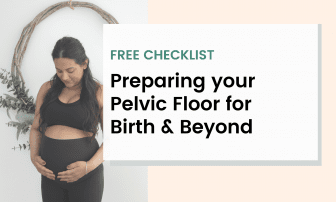Podcast Episode #225
Pelvic girdle pain tips with Physio Fiona from Grdl Pelvic Belt
In this podcast episode today I chat with Physio Fiona from Grdle Pelvic Belt and we all things pelvic girdle pain during pregnancy.
Listen to this episode where we discuss:
-what is pelvic girdle pain?
-how common is pelvic girdle pain?
-when does pelvic girdle pain start during pregnancy?
-what are some treatment options for pelvic girdle pain
-pelvic girdle pain belts – how they can help
-can lower back pain cause pelvic pain?
-how to relieve pelvic pain during pregnancy
If you have pelvic girdle pain I trust you will love this episode. If you know someone with pelvic girdle pain, then be sure to send them this episode.

In this article you'll find tips to:
- Understand pelvic girdle pain
- Recognise the symptoms
- Know when it starts
- Explore treatment options
- Use a pelvic girdle pain belt
- Relieve pelvic pain
- Prevent lower back pain
- Maintain good posture
- Incorporate gentle exercise
- Improve sleep comfort
- Seek professional help

What is Pelvic Girdle Pain?
Pelvic girdle pain (PGP) is a common condition that affects many pregnant women, causing discomfort and pain in the pelvic region. This pain can be felt in the front, back, or sides of the pelvis and can extend to the hips and thighs. Pelvic girdle pain can occur due to a variety of hormonal, mechanical and postural changes that happen during pregnancy. It may lead to difficulty walking, standing, and performing daily activities, making it important to address and manage the symptoms effectively.
How Common is Pelvic Girdle Pain?
Pelvic girdle pain is quite common during pregnancy, affecting approximately one in two to three pregnant women. The severity of the pain can vary, with some women experiencing mild discomfort while others may find it debilitating. The prevalence of PGP highlights the importance of awareness and early intervention to ensure that pregnant women can maintain their mobility and quality of life throughout their pregnancy.
When Does Pelvic Girdle Pain Start?
Pelvic girdle pain can start at any point during pregnancy, but it is most commonly reported in the second and third trimesters. The onset of PGP is often linked to the body’s preparation for childbirth, as a combination of hormonal, postural and mechanical changes occur in the body.
What are Some Treatment Options for Pelvic Girdle Pain?
There are several treatment options available for managing pelvic girdle pain, including:
- Hands on Treatment: A physiotherapist can provide exercises and techniques to strengthen the pelvic floor and core muscles, helping to strengthen and stabilise the pelvic region, whilst maintaining flexibility.
- Exercise Therapy: It may be appropriate to modify exercises to ensure they are suitable with pelvic girdle pain. FitNest Mama includes pelvic girdle pain friendly exercise options safe for pregnancy. Other options may include swapping long walks for water-based exercise, or as advised by your healthcare provider
- Massage Therapy: Prenatal massages can help relieve muscle tension and improve circulation, reducing pain and discomfort.
- Supportive Devices: Using a pelvic girdle pain belt can provide additional support and stability to the pelvic region, reducing pain and improving mobility.
Pelvic Girdle Pain Belt – How It Can Help?
A pelvic girdle pain belt is a specially designed support garment that can help manage the symptoms of PGP. The belt provides compression and stability to the pelvic area, reducing the strain on the joints and ligaments. This can help alleviate pain and improve mobility, allowing pregnant women to continue their daily activities with less discomfort. The pelvic girdle pain belt is adjustable and can be worn throughout pregnancy, making it a convenient and effective solution for managing PGP.
Can Lower Back Pain Cause Pelvic Pain?
Yes, lower back pain can cause pelvic pain. The lower back and pelvis are interconnected, and issues in one area can often lead to discomfort in the other. During pregnancy, the additional weight and changes in posture can place extra stress on the lower back, leading to pain that can radiate to the pelvic region. However, back pain might also be a separate issue, hence it is important to have an appropriate assessment and diagnosis from your healthcare professional. Managing lower back pain through exercises, proper posture, and supportive devices can help reduce the risk of developing pelvic pain.
How to Relieve Pelvic Pain During Pregnancy
Relieving pelvic pain during pregnancy involves a combination of lifestyle adjustments and treatments. Here are some tips to help manage and reduce pelvic pain:
- Exercise Regularly: Engage in gentle exercises that are appropriate for pelvic girdle pain, such as prenatal pilates, swimming, and prenatal yoga, to strengthen the pelvic floor and core muscles.
- Maintain Good Posture: Avoid slouching and practise good posture to reduce strain on the pelvis and lower back.
- Use Supportive Devices: Consider using a pelvic girdle pain belt to provide additional support and stability to the pelvic region.
- Take Breaks: Avoid standing or sitting for long periods. Take regular breaks to move around and stretch.
- Sleep Positions: Use pillows to support your legs and lower back while sleeping to reduce pressure on the pelvis.
- Consult a Professional: Seek advice from a healthcare provider, physiotherapist, or chiropractor for personalised treatment options.
By following these tips and using supportive devices like a pelvic girdle pain belt, pregnant women can effectively manage pelvic girdle pain and maintain their comfort and mobility throughout their pregnancy.
** This podcast has general information only. Always seek the guidance of your doctor or other qualified health professional with any questions or concerns you may have regarding your health or medical condition.
Links
Preparing for birth Pelvic health checklist
Free 7 Day Trial Pregnancy Workouts
Free 7 Day Trial Postnatal Workouts
FitNest Mama Website
Instagram @fitnestmama
Fiona’s Instagram: @pelvicwellnessphysio
Grdl Website: https://grdlbelt.com.au/
Grdl Instagram: @grdlbelt


